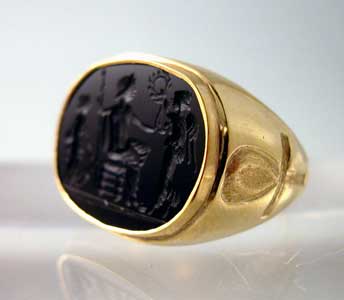Gold Ring with a Classical Revival Onyx Intaglio Depicting a Mythological Scene, 18th Century CE
Gold and Onyx
FJ.6664
Further images
The art of glyptics, or carving on colored precious stones, is probably one of the oldest known to humanity. Intaglios, gems with an incised design, were made as early as...
The art of glyptics, or carving on colored precious stones, is probably one of the oldest known to humanity. Intaglios, gems with an incised design, were made as early as the fourth and third millennia B.C. in Mesopotamia and the Aegean Islands. The exhibit a virtuosity of execution that suggests an old and stable tradition rooted in the earliest centuries. The tools required for carving gems were simple: a wheel with a belt-drive and a set of drills. Abrasives were necessary since the minerals used were too hard for a metal edge. A special difficulty of engraving intaglios, aside from their miniature size, was that the master had to work with a mirror-image in mind.
The Classical Revival was a phenomenon that swept through Europe in the 18th and 19th Centuries. A new appreciation for antiquity and ancient art forms was fostered by discoveries in the nascent scientific field of archaeology. Perhaps the Classical Revival also reveals a latent longing towards the Arcadian lifestyles of yesterday abandoned as Europe became rapidly industrialized and increasingly urbanized. Engraved onto the polished surface of this precious stone is the image of a mythological scene depicting three figures. In the center, a deity or emperor is enthroned, holding a staff in his right hand. Winged Victory stands to the right, approaching the enthroned figure and crowning him with a laurel wreath, the traditional mark of a champion. To the left, behind the emperor, stands Fortuna, the Goddess of Chance, who holds a rudder, one of her traditional attributes that implies she has the power to steer the course of our lives. Clearly, she has guided the emperor into a successful position in life, for he is in the middle of being crowned by Victory herself. This lovely intaglio reveals the fascination for all things ancient during the Victorian Era.
The Classical Revival was a phenomenon that swept through Europe in the 18th and 19th Centuries. A new appreciation for antiquity and ancient art forms was fostered by discoveries in the nascent scientific field of archaeology. Perhaps the Classical Revival also reveals a latent longing towards the Arcadian lifestyles of yesterday abandoned as Europe became rapidly industrialized and increasingly urbanized. Engraved onto the polished surface of this precious stone is the image of a mythological scene depicting three figures. In the center, a deity or emperor is enthroned, holding a staff in his right hand. Winged Victory stands to the right, approaching the enthroned figure and crowning him with a laurel wreath, the traditional mark of a champion. To the left, behind the emperor, stands Fortuna, the Goddess of Chance, who holds a rudder, one of her traditional attributes that implies she has the power to steer the course of our lives. Clearly, she has guided the emperor into a successful position in life, for he is in the middle of being crowned by Victory herself. This lovely intaglio reveals the fascination for all things ancient during the Victorian Era.







